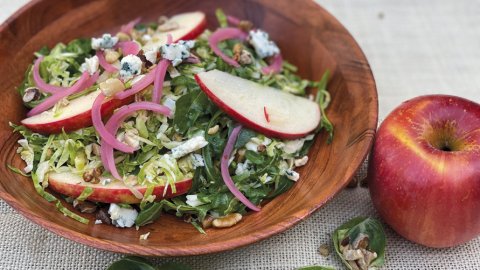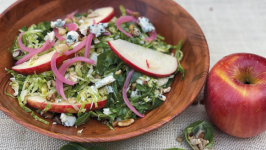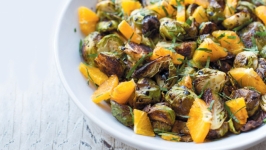Sweet Facts about Brussels Sprouts
Brussels sprouts, those mini cabbages that used to get boiled to death until they topped many kids’ lists of most-hated vegetables, are finding new chic with the rising popularity of other cooking methods that bring out their nutty sweetness. Even the Cookie Monster from “Sesame Street” is a fan, and took kids on a video road trip to see where they are grown.
Not surprisingly, that adventure led to Giusti Farms in Half Moon Bay where John Giusti took the young viewers and the fun-loving food curious on walking tour among the towering green stalks. Turns out Brussels sprouts are the top crop in San Mateo County. Coastal farmers in that county dedicate 788 acres to growing them, with the 2018 crop valued at $14.2 million.*
In recent years, home cooks, families, even Michelin-starred chefs are finding new ways to roast, season, batter and serve them, earning the respect of the pickiest palates. Plus, there’s a bonus to bringing them to center plate: Brussels sprouts are super nutritious, with high levels of vitamins A and C, folacin and fiber.
A three-ounce serving contains about as much vitamin C as an orange and only 60 calories. Members of the cruciferous family, they contain phytonutrients that are being researched to help fight cancer, decrease inflammation and improve blood sugar levels.
A Cool Little History
Believed to have originated in Italy during Roman Empire times, Brussels sprouts were first grown in large quantities in Belgium in 1200, hence the moniker “Brussels.” The first mention in the U.S. is from Thomas Jefferson’s records in 1812. They arrived in California in the 1920s, when Italian immigrants found that the rich land and mild, cool climate along the San Mateo coast provided the perfect spot for this sometimes-biennial crop to take root, with significant production beginning in the 1940s.
Today, the demand is undeniable. Approximately 70% of the harvest from local farms is sold to brokers in Salinas, and 30% is sold directly via farmers and community markets, and to restaurants.
More Flavor, Less Water
While Brussels sprouts are grown year-round in parts of California, the local harvest is August through February, when it’s cool and rainfall is relatively plentiful. Heat and drought increase the bitter taste and pungency of the sprouts, while cold and damp conditions mellow them out. Ed Riley of Giusti Farms—considered by many to be “the father of dry farming Brussels sprouts”—has been able to decrease the amount of watering per month from 25 days to 18 days.
This helps, but with current California drought conditions even this “dry farming” may not be dry enough. Most farms have been forced to cut back their overall acreage of Brussels sprouts, adding pressure on the prices and sourcing.
Benefits as a Rotating Crop
In an effort to protect biodiversity, replenish soil fertility and ensure superior flavor, local Brussels sprout farmers plant cover crops, add compost to the soil and select the best times and methods for tilling and rotating crops. Because sprouts attract more insects than other row crops, farmers use pesticides approved for organic farming. The concentration is relatively low: 2 ounces per 400 gallons of water, which covers 10 acres. To ensure food safety the sprouts are tested for residue levels before harvest.
A Sweeter Tomorrow
Because Brussels sprouts are earthy and sometimes a bit bitter, area farmers are planting new varieties that produce sweeter crops. At Cabrillo Farms, David Lea is always looking to bring tastier Brussels sprouts to market. “Cabrillo Farms establishes four test plots every year where seed breeders from the Netherlands plant new cultivars to test against climate, soil, growing seasons and flavor,” he says. Other Brussels sprout growers—including Giusti Farms, Iacopi Farms, Blue House Farm, Potrero Nuevo Farm, Swanton Berry Farm and Rodoni Farms—continue to bring new life and a newfound celebrity status to this long-time regional star crop.
Unfortunately, as demand has increased, large monocrop farms are getting into the business and pushing out local Bay Area farms. Most of these are not local and are processing sprouts from Mexico and SoCal, resulting in variability of supply and lower prices for local farmers. But more importantly, these imported sprouts do not have the same flavor as those grown locally, and Ed Reilly of Giusti Farms summarizes it best, “mass-produced Brussel sprouts grown in hotter, drier climates are traditionally more bitter, while the cool, perfect growing conditions on the San Mateo coast bring out a sweeter, refined flavor.”
One more reason to know your local farms, and give locally grown Brussel sprouts a greenlight to return to home plate.
* San Mateo County/Silicon Valley Convention & Visitors Bureau, Sept. 25, 2019





